Fermented pickles are a treat loaded with probiotics and a delicious sour pickle taste. These are the original, old-school, traditional, deli-style pickles that are nostalgic for many people. Fermented pickles are the real deal, are easy to make, and are rooted in lacto-fermented history!
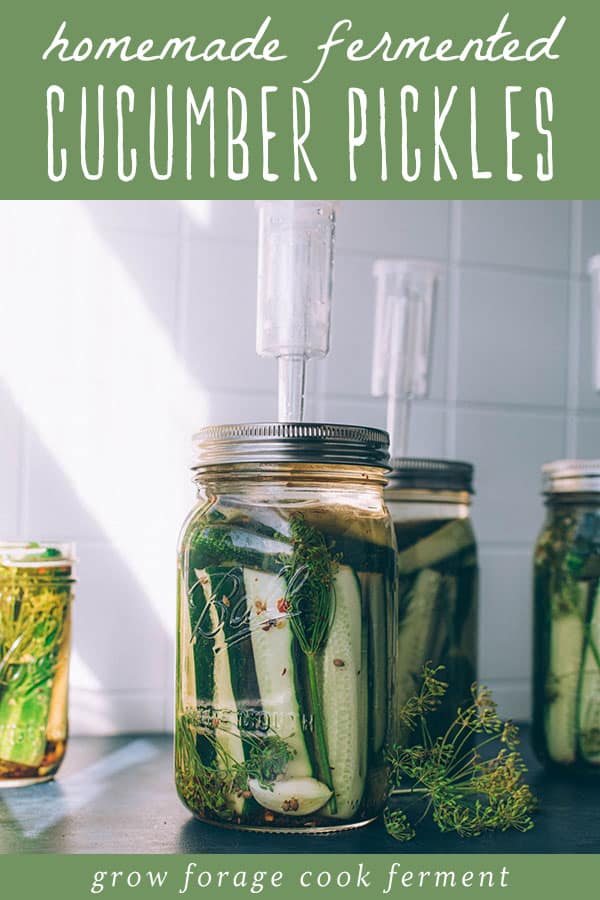
Want to save this post for later?
What’s the Difference Between Fermented Pickles and Regular Pickles?
I absolutely love fermented cucumber pickles, they were probably what initially got me into fermenting, to begin with. I’ve been a pickle lover ever since I was a kid, and love all varieties, including canned vinegar pickles, refrigerator bread and butter pickles, and dill pickles.
The main difference is that fermented pickles use saltwater brine and time to ferment, while other varieties are soaked and pickled in a vinegar solution and canned to be shelf stable.
My mom makes awesome sweet bread and butter pickles, and her dill pickles are to die for, but there is something to be said for traditionally fermented cucumber pickles. They have that authentic deli taste that I crave, and they are super easy to make!
This is hands down the best way to make pickles, and it is truly a historical way to do it – fermenting is the original way to preserve foods so I feel like I’m getting back to my roots any time I ferment!
Related: How to Preserve Cucumbers: Ferment, Can, Freeze and More!
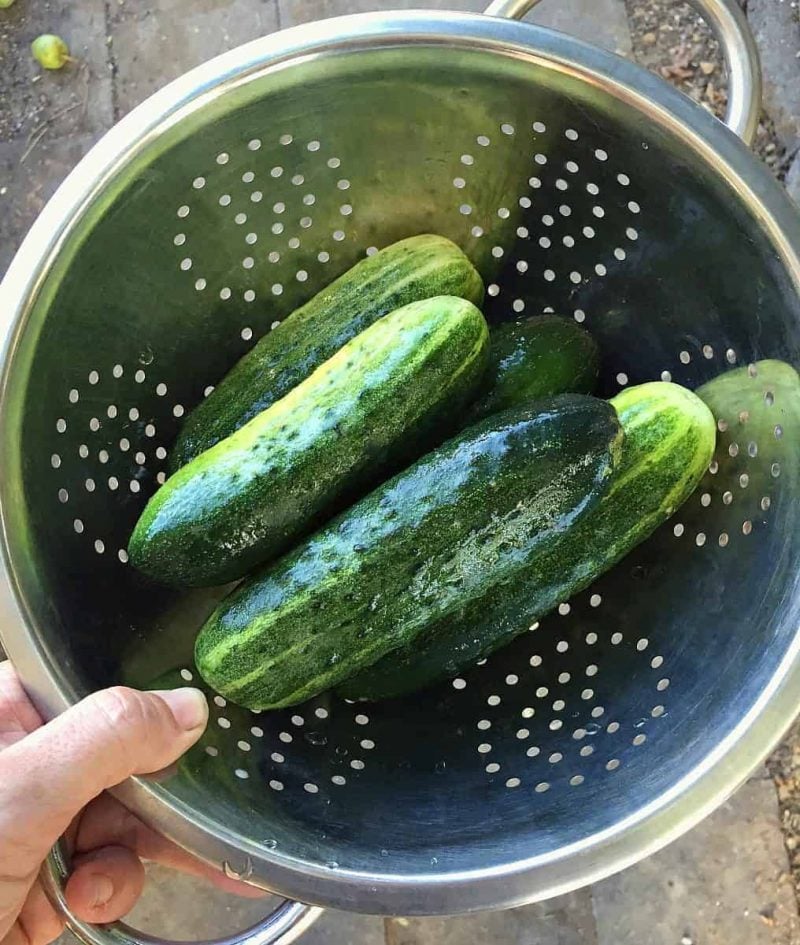
Cucumbers for Fermenting
I suppose what prompted this post is that my local natural food co-op had these amazing-looking pickling cucumbers in stock.
I’m growing my own cucumbers to pickle, but they won’t be ready for a good while. I figured I’d get ahead of the game and make some fermented cucumber pickles now while I had the opportunity!
Pickling cucumbers work best in this recipe, as they are less seedy and watery than regular slicing cucumbers. They are also the best choice for making kosher dill pickles, which are canned and not fermented.
How to Make Fermented Cucumber Pickles
Ingredients
- Pickling salt or sea salt – make sure you don’t use iodized salt.
- 1 quart of water – unchlorinated water is important since chlorine will disrupt the fermentation process, so filtered or bottled water is best.
- Pickling cucumbers – You can use other types of cucumbers, but regular pickling ones are best!
- Whole fresh dill flowers – or dried dill seeds.
- Fresh garlic – for the absolute best garlicky taste!
- Pickling spices – use your favorites: peppercorns, mustard seeds, coriander seeds, and red pepper flakes. A pickling spice blend works great too if preferred.
This recipe will make 2 quarts of pickles. The number of cucumbers to use will vary depending on their size. As you can see, this recipe is very customizable, so make your pickles how you like them!
Ferment the Pickles
First, make the brine by combining the water and salt in a pitcher or jar and stirring until the salt is dissolved.
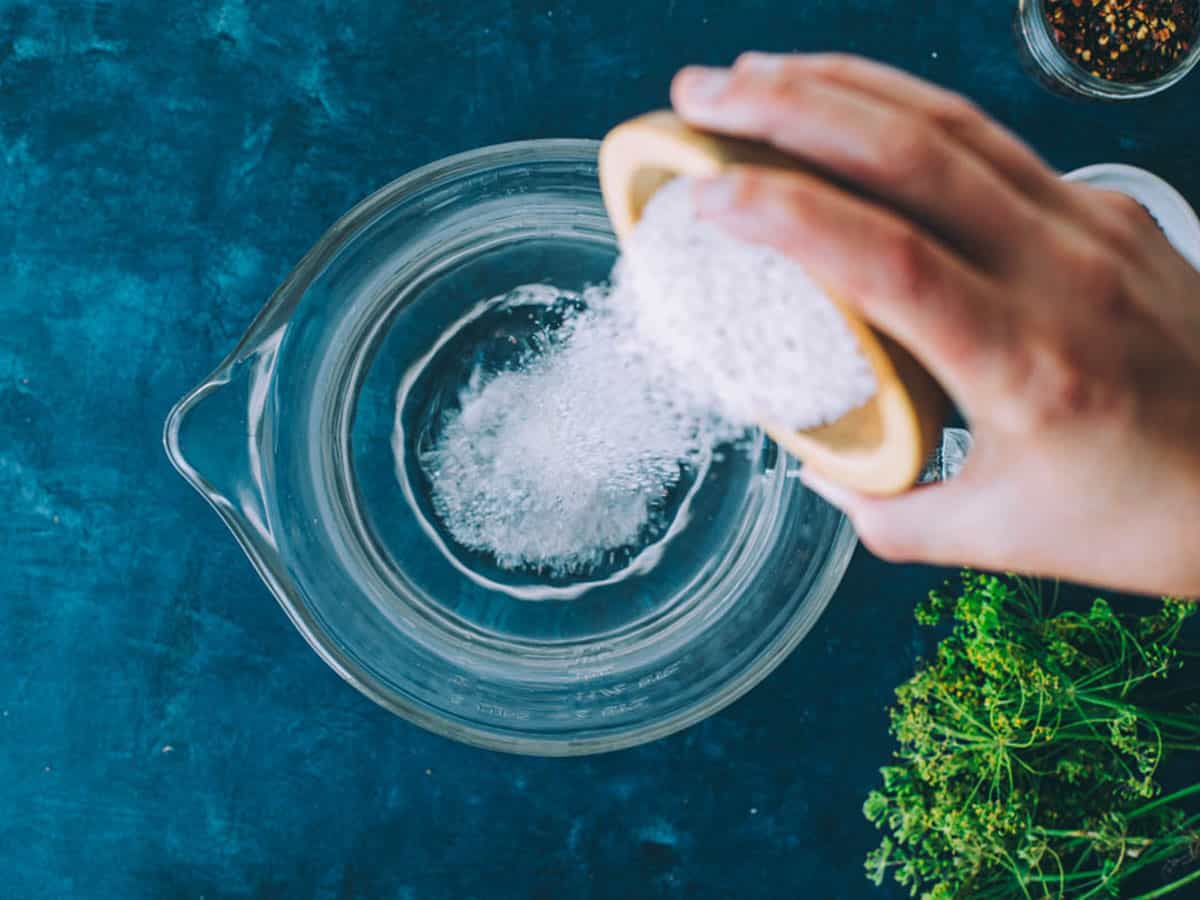
Then divide the dill, garlic, and spices into two 1-quart jars.
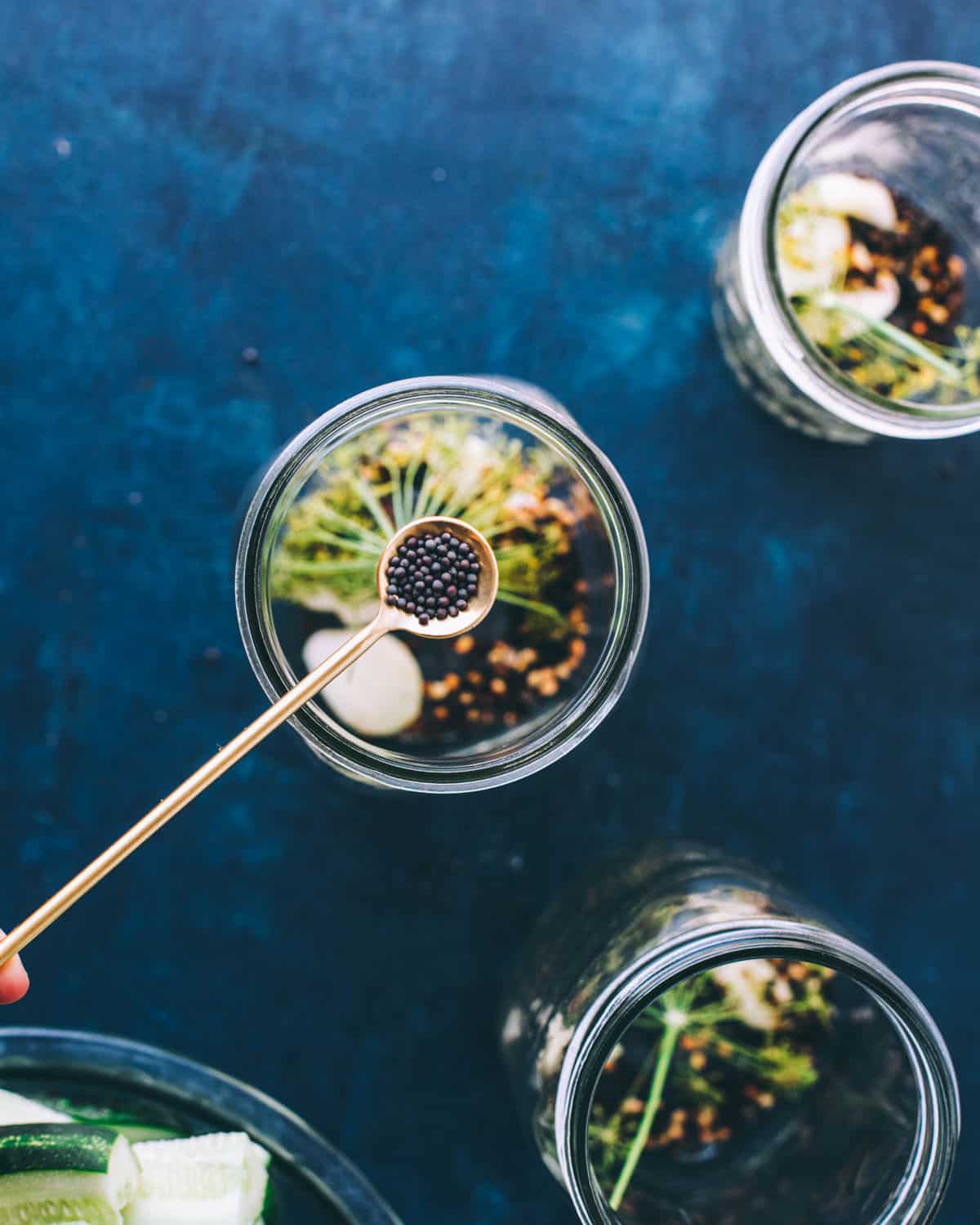
Cut both ends off of the cucumbers and cut them into spears. Add as many cucumber spears into the jars with the spices as can fit. The more the merrier!
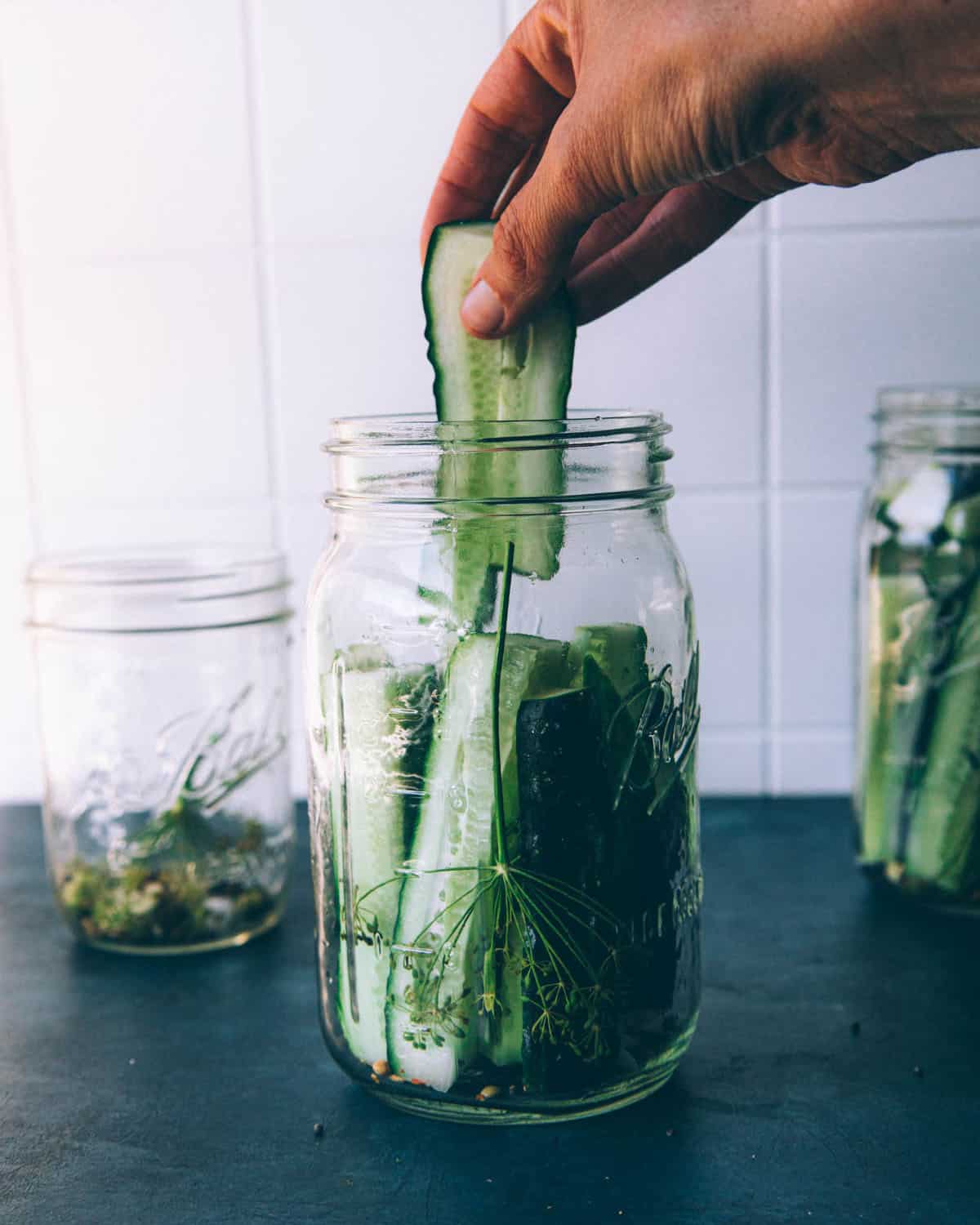
Fill the jars with the saltwater brine, leaving an inch of headspace.
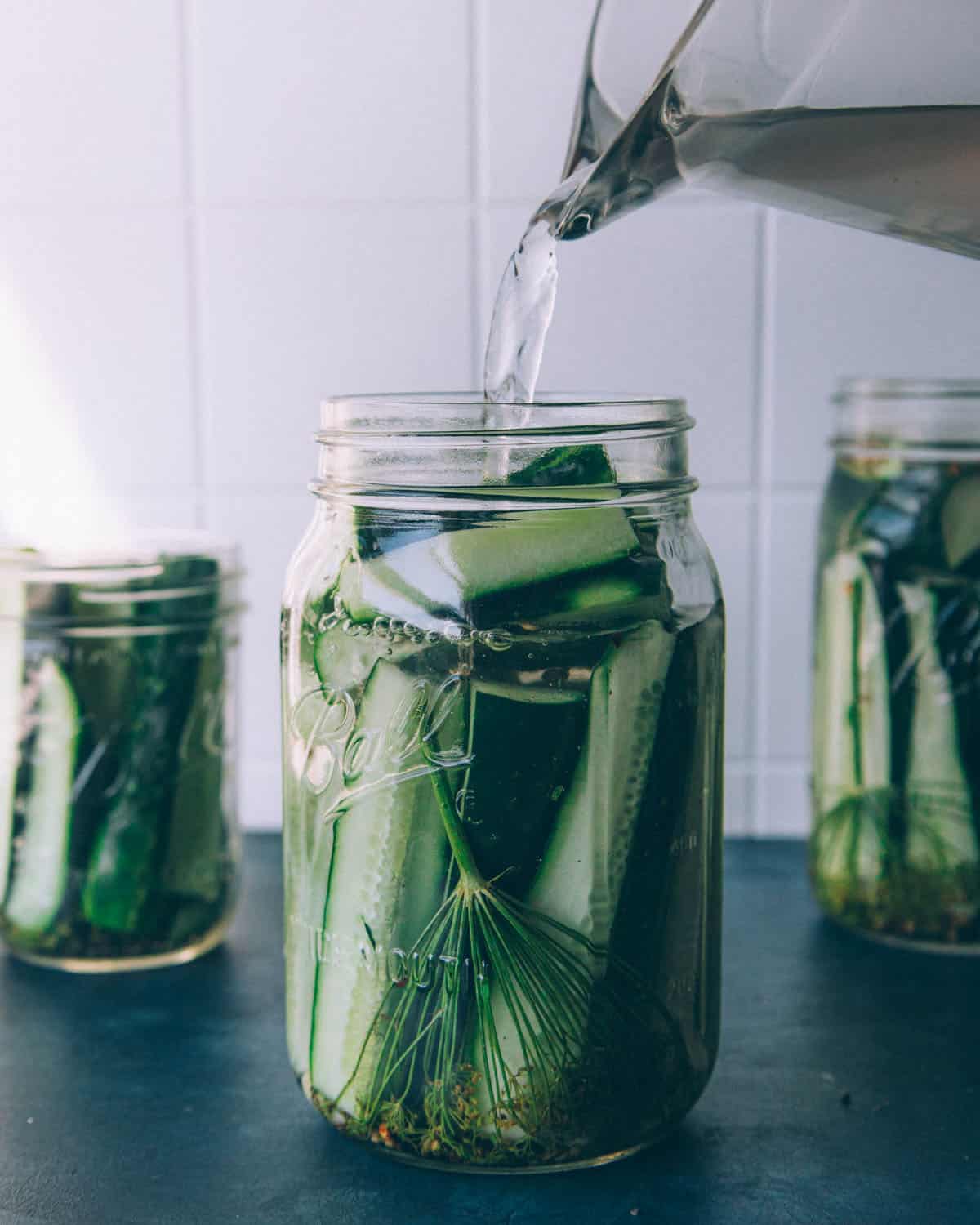
Use a fermentation weight to keep your cucumbers under the brine, and cap it with an airlock lid.
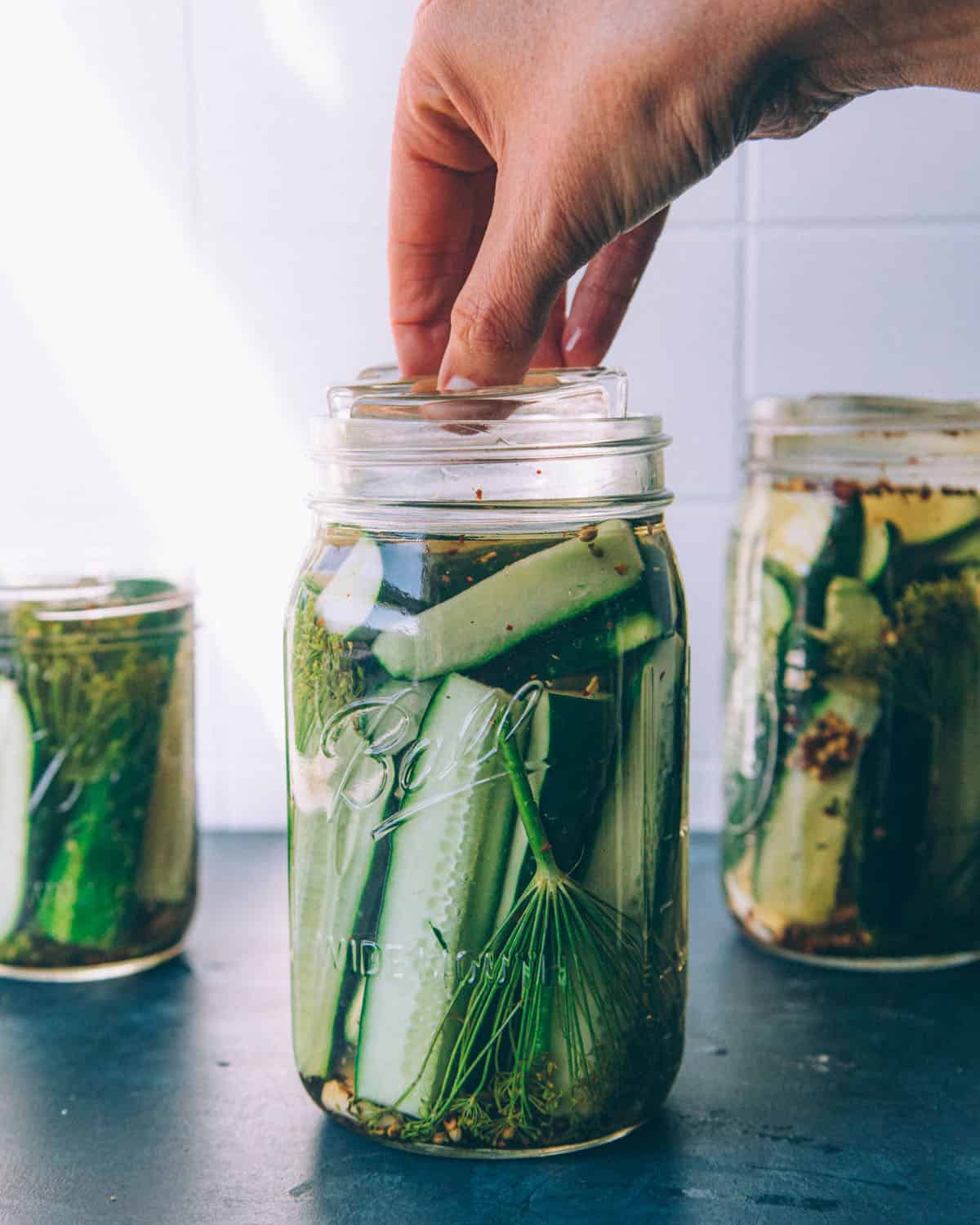
I will often use a super clean smaller jar filled with water as a weight, covered with a kitchen towel to keep dirt and bugs out, so that is an alternative if you don’t have fermentation weights and lids.
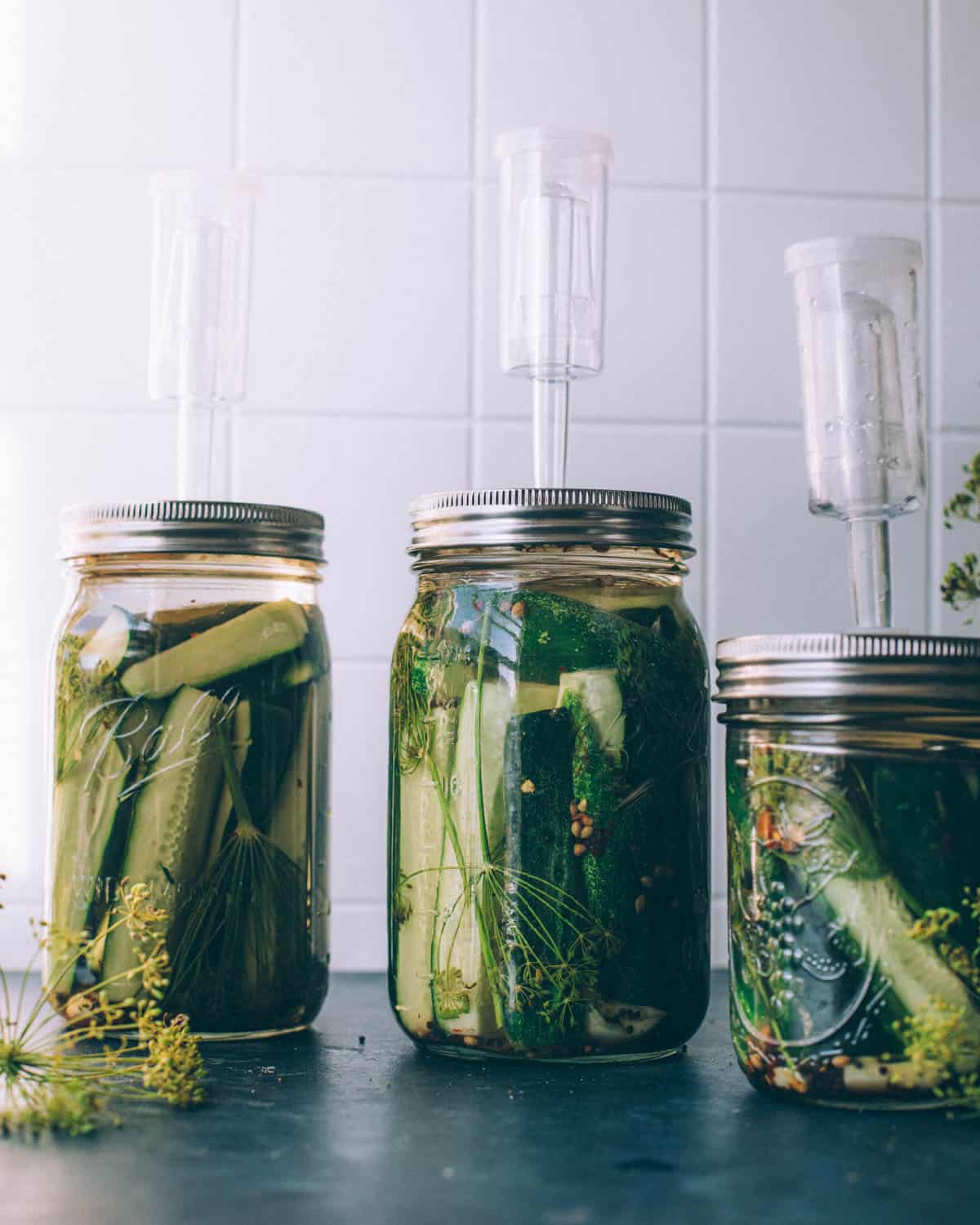
Put the jars in a cool place out of direct sunlight.
If you’re using the smaller jar weight method, put them on a plate as there may be a bit of brine leakage as the cucumbers extract some of their liquid.
Check the jars every few days to see how they’re doing.
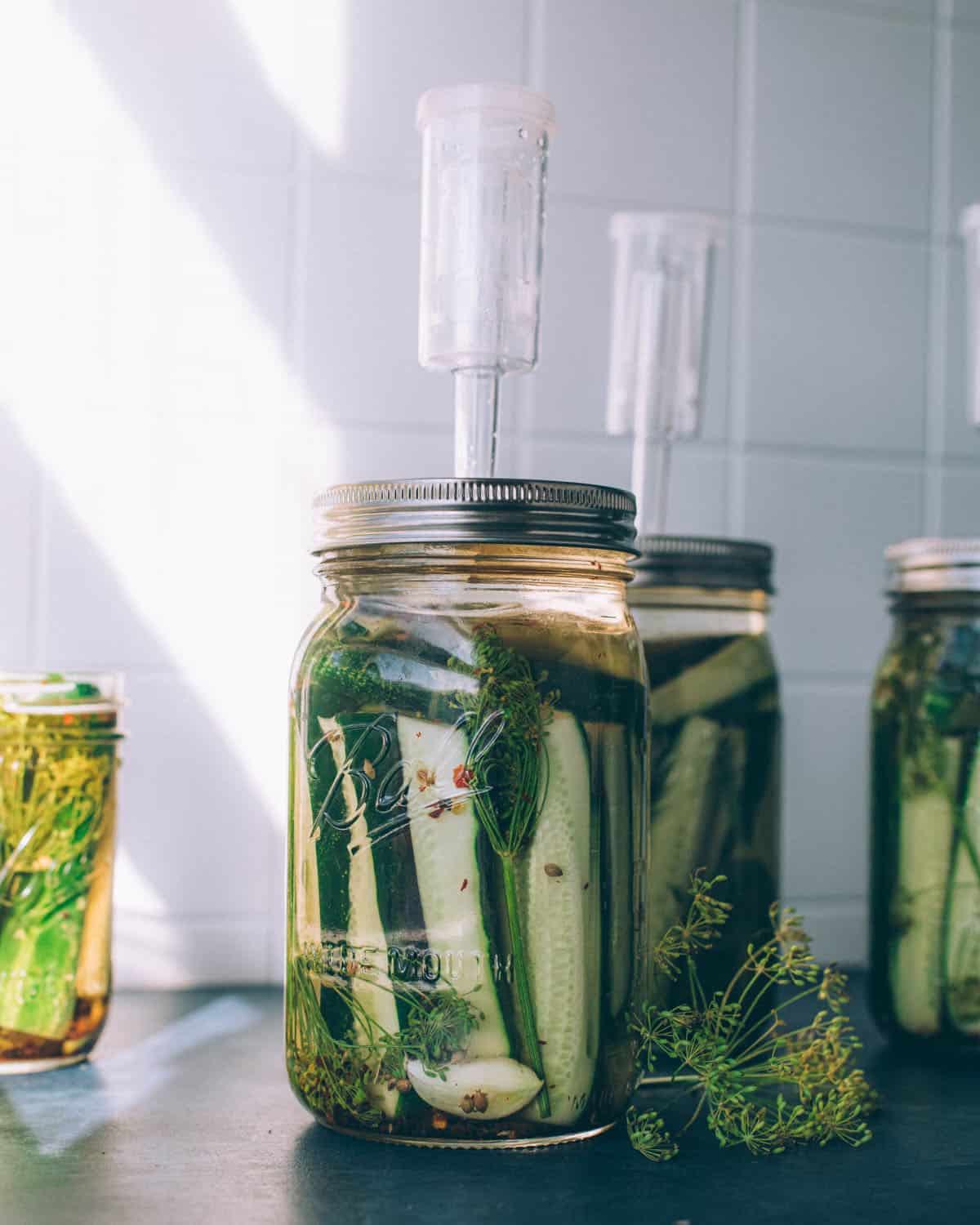
A good way to know your fermented pickles are finished is when they are paler green in color and a bit softer, but not mushy. In general, it’s about 3-6 days, but can vary with the ambient temperature and other factors.
Give one a taste if you’re unsure, and once they taste how you like them, then they are done! If they don’t quite have that traditional deli-style taste you want, keep fermenting them until they do.
Then you can revel in pickle-y goodness!
These are so tasty, they don’t last very long at my house. You gotta get ’em while they’re hot!
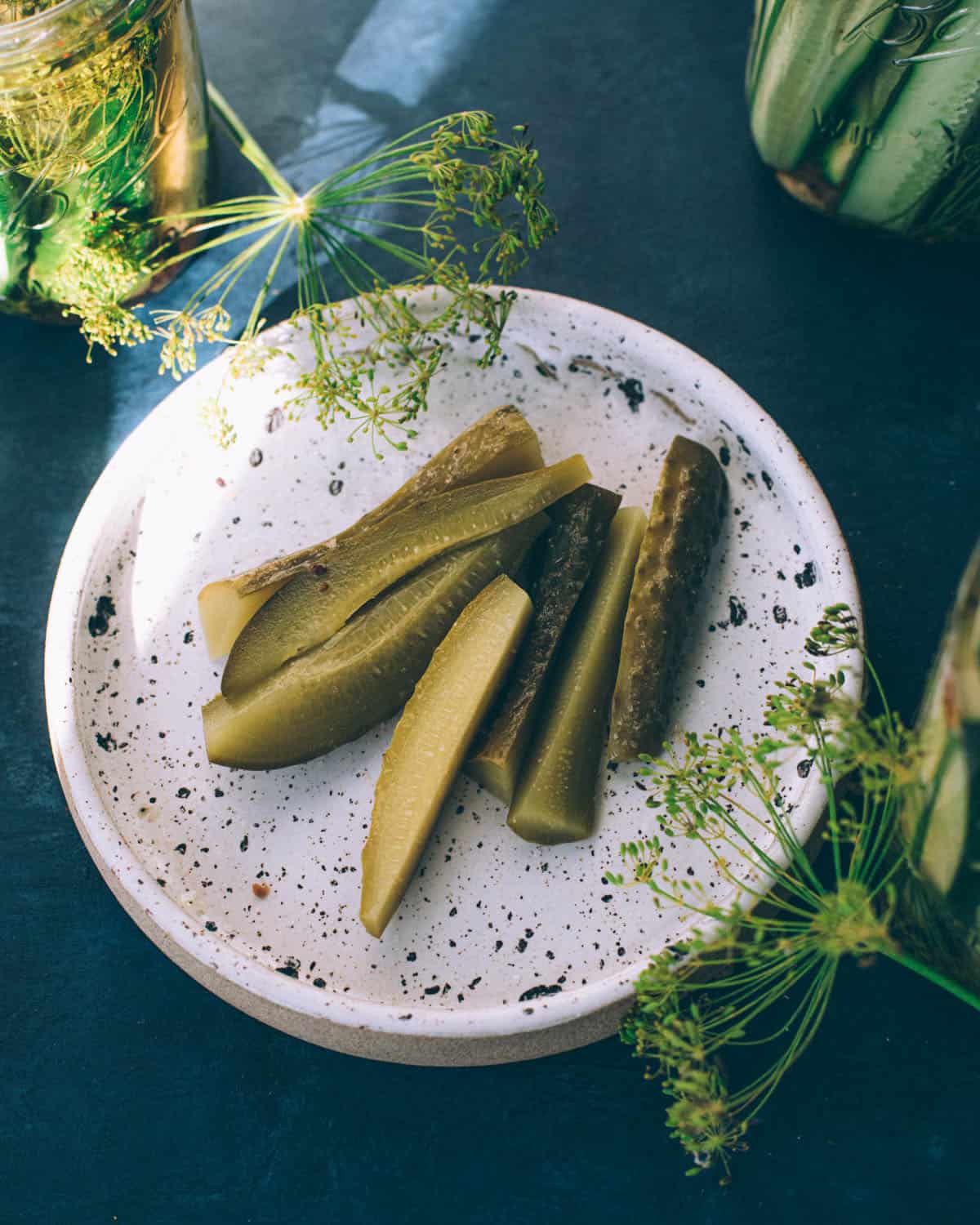
How Long do Fermented Pickles Last?
To store fermented cucumber pickles once they’re done fermenting, take off the airlock cap, close with a regular lid, and store in the refrigerator.
Once fermented, these pickles can last months up to a year. They’re so good, I doubt they will last that long before getting eaten! If you notice some getting mushy or slimy, that’s an indication that they are past their best moment.
A Note on Botulism
You may be wondering about the risk of botulism, this is a question I get often with fermented recipes.
Botulism is really not a concern with fermented pickles, just like any other lacto-fermented food. Low-acid canned or preserved foods are sometimes a concern for botulism, but this is not the case here.
More Fermented Vegetable Recipes
Here are some of my other favorite fermented vegetable recipes:
- How to Make Sauerkraut
- How to Make Kimchi
- How to Make Fermented Hot Sauce
- Fermented Jalapeno Hot Sauce
- Fermented Green Tomatoes
- Fermented Cherry Tomatoes
- Fermented Asparagus with Garlic
- Lacto-Fermented Dilly Beans
- Fermented Garlic
Fermented Cucumber Dill Pickles
Ingredients
- 3 Tbsp kosher, pickling, or sea salt do not use iodized salt
- 1 quart non-chlorinated water
- 2-4 whole fresh dill flowers or 1 tsp dill seeds
- 2-4 garlic cloves
- ¼ tsp spices to taste: peppercorns, mustard seeds, coriander seeds, red pepper flakes or substitute with a pickling spice blend
- 6-12 pickling cucumbers
Instructions
- Make the brine by combining the salt and water in a pitcher or jar and stir well to dissolve the salt.
- Divide the dill flowers, garlic, and spices into two 1-quart jars.
- Trim the ends of the cucumbers and cut them into spears (or halves if they are on the small side). Place the cucumbers into the two 1-quart jars with the herbs and spices, filling them as much as you can.
- Fill the jars with the saltwater brine, leaving an inch of headspace.
- Place a fermentation weight over the vegetables to keep them under the brine. Cap the jars with fermentation lids.
- Place the jars in a cool place out of direct sunlight. Check them every few days to see how they’re progressing.
- The pickles will be finished when they're paler green in color and a bit softer, but not mushy – this usually takes about 3-6 days. Give them a taste to be sure they're to your preference. If not, ferment a bit longer.
- Once the fermented cucumber pickles are done fermenting, take off the airlock cap, close with a regular lid, and store in the refrigerator. They will last many months or even up to a year in the refrigerator.
Notes
- Pickling cucumbers work best in this recipe, as they are less seedy and watery than regular slicing cucumbers.
- Unchlorinated water is important since chlorine will disrupt the fermentation process, so filtered or bottled water is best.
- An alternative if you don’t have fermentation weights and lids is to use a super clean smaller jar filled with water as a weight, covered with a kitchen towel to keep dirt and bugs out.
- If you’re using the smaller jar weight method, put them on a plate as there may be a bit of brine leakage as the cucumbers extract some of their liquid.
- Botulism is really not a concern with fermented pickles, just like any other lacto-fermented food.

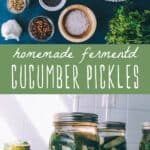
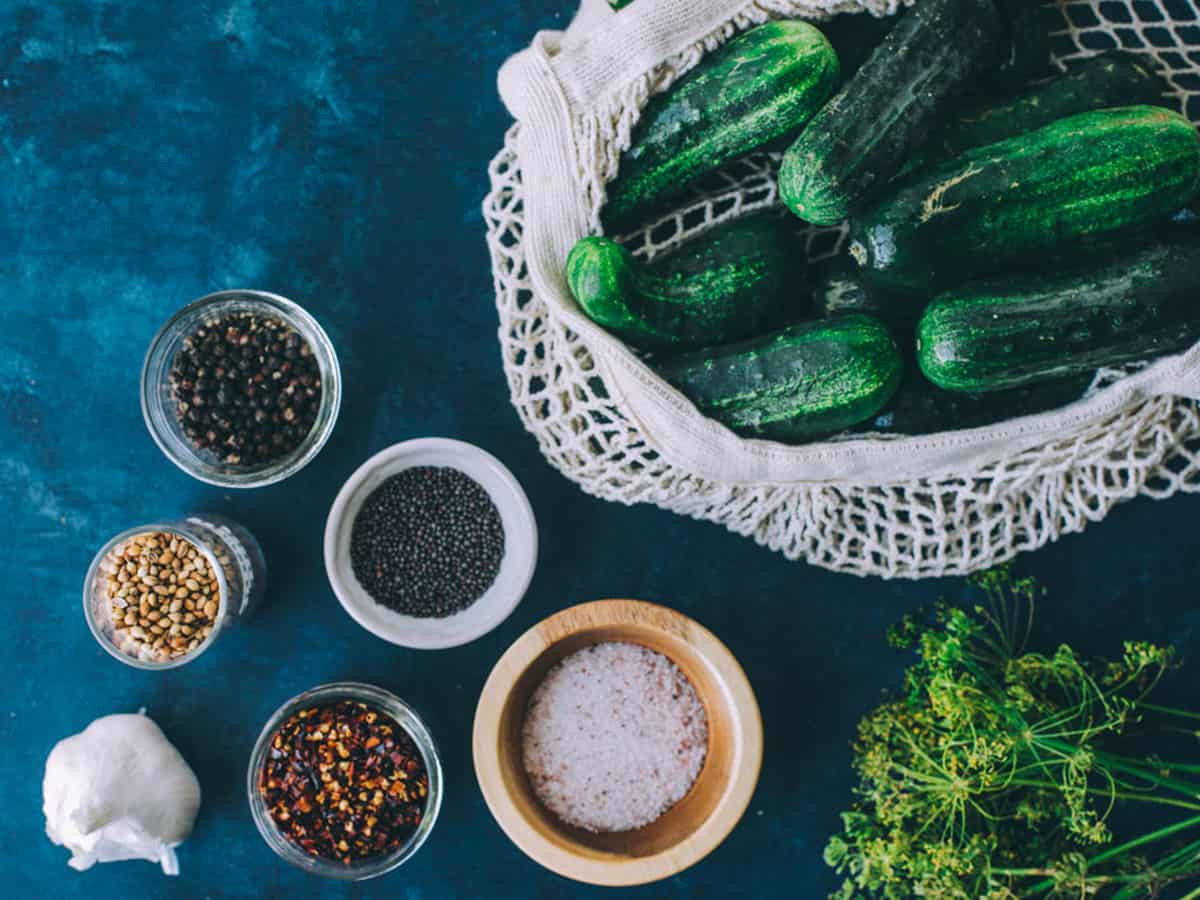
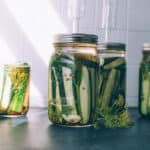

I just bought a bottle of freeze-dried Dill Weed for another recipe. How much should I use for this recipe?
I’ve never used freeze dried herbs, so I can’t really give you a ratio to use. I would taste it and decide whether or not you think it’s as strong as fresh dill and base your decision on how much to use on that.
I used 3 Tablespoons of pickling salt to the 1 quart of spring water. The pickles were beyond salty. Should the pickling salt be significantly less? I read add more water to brine but the pickles had already absorbed the salt. Please advise. Thank you.
If they taste too salty, they likely need more fermentation time They become more acidic as they ferment and that acidity will balance out the saltiness.